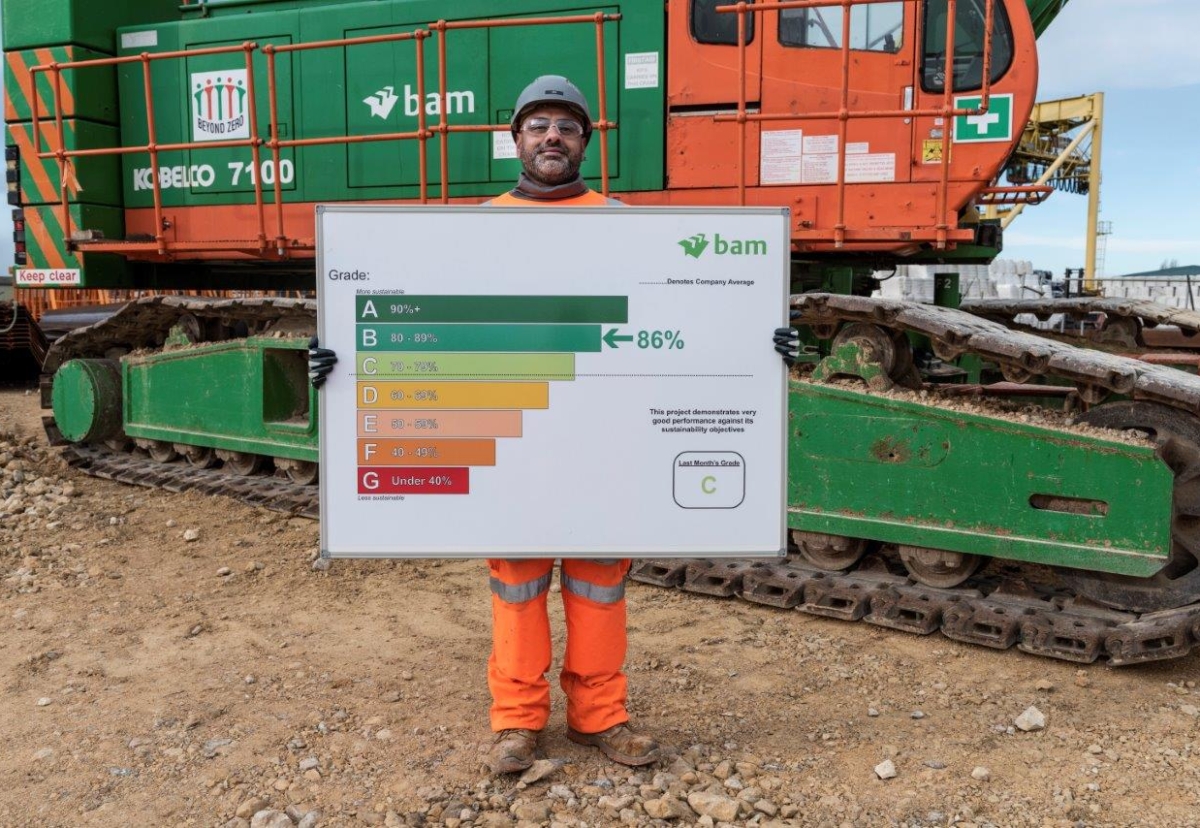The system is based on the simple coloured bar energy efficiency rating used on all household goods but grades the sustainability of the fiirm’s sites.
The ‘sustainability index’ which grades every project for its overall environmental and social impact delivered big improvements at trial civil engineering sites over the last 12 months.
Sarah Jolliffe, BAM Carbon Reduction lead, said: “Over the last 12 months, we’ve seen our average project rating rise from a ‘D’ to a ‘C’.”
“It is a simple and transparent way of understanding the overall sustainability impact of our projects.
“Not only does it allow us to keep our own environmental and social impact in check, it also allows our customers to monitor our sustainability performance.”
The Sustainability Index considers 13 measures across BAM Nuttall projects, which include key sustainability elements such as carbon intensity, construction waste intensity, environment compliance, good practice and social impact.
The data used to generate the project’s score is gathered from a range of sources and is grouped into five categories: data presence, carbon performance, waste performance, compliance and ‘demonstrating success’.
This information allows projects to be scored each month, with projects being graded between A and G, like an energy efficiency rating used on household goods.
The index has helped project managers to identify specific areas where improvements can be made, enabling projects to implement changes and strive towards sustainability excellence. As well as recognising high performing projects, the index recognises projects that have made substantial improvements to their score over time.
Project Led Initiatives
Carbon reduction:
– The team building the new sea wall at Dawlish improved their score from a ‘D’ to ‘C’ by using ultra low-carbon concrete reducing the embodied carbon of the scheme by an impressive 1,200tCO2e when compared to the initial tendered design. This is the equivalent of removing approximately 760 cars off the road. The project also uses the biofuel HVO which improved its direct carbon emissions score.
– At Hebden Bridge, the team improved to ‘B’ from ‘C’ by improving performance across waste and carbon intensity. The site has mobilised on a grid power connection and utilises HVO which contribute to lowering emissions.
Social impact:
– At Great Yarmouth 3rd river crossing, the team’s continued focus on social impact and STEM engagement contributed to moving up to ‘B’ from ‘C’.
Waste reduction:
– The Black Potts Weir project team improved waste performance by onsite reuse of timber formwork, which reduced their construction waste intensity and lifted their score to ‘B’ from ‘C’.
Good practice and innovation:
– Stubbington Bypass secured a ‘B’ following efforts to decarbonise through its use of 3D printed concrete culvert headwalls and reducing the amount of hard landscaping.
– At Stourton Park and Ride scheme the project have improved their environmental data resulting in a change to ‘B’ from ‘C’ grade. The project also scored well in the good practice section for using solar panels on the finished scheme, and for helping to influence the client’s decision.
– The team at Leeds Flood Alleviation Scheme showed considerable improvement in compliance taking their overall position from ‘C’ to ‘B’. This was due to prompt close out of environmental inspection findings and securing only 100% sustainable timber for use on the project.
Team collaboration and commitment:
– The Riverlinx team, a joint venture between BAM, Ferrovial and SK Ecoplant, delivering Silvertown Tunnel project saw one of the largest improvements due to a concerted effort across the team to lift from ‘D’ to ‘B’.






.gif)









 (300 x 250 px).jpg)





































